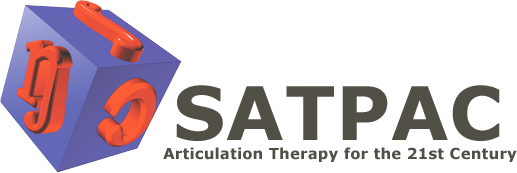

Research
SATPAC is a scientifically research-based articulation therapy program for the 21st century.
Here are peer-reviewed studies showing the effectiveness of the SATPAC Approach:
Flipsen, P, Sacks, S., (2022) The SATPAC Approach and Remediation of Speech Sound Errors in an RTI Context: A Replication. Perspectives on School-Based Issues, Vol. 7, No. 3, 912-925
Flipsen, P, Sacks, S., (2017) Efficacy of the SATPAC Approach for Treating Persistent /r/ Errors. ASHA Convention, Los Angeles, CA
Sacks, S., (2017) Using the SATPAC Program & Approach with Middle School Students with Highly Unintelligible Speech. ASHA Convention, Los Angeles, CA
Flipsen, P, Sacks, S., (2015) Remediation of residual /r/ errors: A case study using the SATPAC approach. Perspectives on School-Based Issues, Vol. 16, No. 3, 64-78
Sacks, S., Flipsen, P., & Neils-Strunjas, J. (2013) Effectiveness of Systematic Approach Training Program Accessing Computers (SATPAC) Approach to Remediate Dentalized and Interdental /s,z/ : A preliminary study. Perceptual & Motor Skills, 117, 559-577.
Sacks, S., Flipsen, P., (2013) Efficacy of the SATPAC Approach for Remediating Persistent /s/ Errors. ASHA Convention, Chicago, IL
SATPAC is a versatile eclectic program supported by research over the past 40 years. Techniques used in SATPAC have been tried, tested and endorsed by the leading SLPs in our field as noted in the following sources below:
Bankson, N. W., Bernthal, J. E. (1998) Remediation Concepts, Principles, and Methodologies. In Bernthal, J. E. and Bankson, N. W. (Eds.) Articulation and Phonological Disorders (pp. 299-377). Needham Heights, MA : Allyn & Bacon.
Bleile, K. (2006). The Late Eight. San Diego, CA : Plural Publishing
Boshart, C.A. (1997). Essential Oral-Motor Techniques, A One-Day Workshop. Temecula, CA : Speech Dynamics.
Bradley, D. P. (1985) A systematic multiple-phoneme approach to articulation treatment. In N. A. Creaghead, P. W. Newman, & W. A. Secord (Eds.), Assessment and Remediation of Articulation and Phonological Disorders (pp. 315-333). Columbus, OH : Merrill
Compton, A. (1970). Generative studies of children’s phonological disorders. Journal of Speech and Hearing Disorders, 35, 315-339.
Ertmer, D. J., & Ertmer, P. A. (1998) Constructivist Strategies in Phonological Intervention: Facilitating Self-Regulation for Carryover. Language, Speech, and Hearing Services in Schools. 29, 67-75.
Elbert, M., & McReynolds, L. V., (1978). An experimental analysis of misarticulating children’s generalization. Journal of Speech, Language, and Hearing Research. 21, 136-139.
Elbert, M., Dinnsen, D. A., Swartzlander, P. & Chin, S. B. (1990) Generalization to conversational speech. . Journal of Speech and Hearing Disorders, 55, 694-699.
Gerber, A. (1973) Goal: Carryover. Philadelphia , PA : Temple University Press.
Gierut, J. A. (1992). The conditions and course of clinically induced phonological change. Journal of Speech, Language, and Hearing Research. 35, 1049-1063.
Gierut, J. A. (1999). Syllable Onsets: Clusters and Adjuncts in Acquisition. Journal of Speech, Language, and Hearing Research. 42, 708-726
Gierut, J. A. (2001). Complexity in Phonological Treatment: Clinical Factors. Language, Speech, and Hearing Services in Schools. 32, 229-241.
Gierut, J. A. & Champion, A. H. (2001). Syllable Onsets II: Three-Element Clusters in Phonological Treatment. Journal of Speech, Language, and Hearing Research. 44, 886-904.
Gierut, J. A. (2005). Phonological intervention: the how or the what? In A. Kamhi & K. Pollock (eds.) Phonological disorders in children: Clincal decision making in assessment and intervention (pp. 201-210). Baltimore : Brookes.
Glaser, A. J., & Donnelly, C. (1989). Data-Based Supervision Methods for Speech-Language Pathology. Language, Speech, and Hearing Services in Schools. 20, 296-304.
Ingram, D. (1981).Procedures for the Phonological Analysis of Childen’s Language. Baltimore , MD : University Park Press.
Kamhi, A. G. (2000). Practice Makes Perfect: The Incompatibility of Practicing Speech and Meaningful Communication. Language, Speech, and Hearing Services in Schools. 37, 271-279.
Kamhi, A. G. (2006). Treatment Decisions for Children With Speech-Sound Disorders. Language, Speech, and Hearing Services in Schools. 37, 271-279.
Kent, R. D. (1982). Contextual facilitation of correct sound production. Language, Speech, and Hearing Services in Schools. 13, 66-76.
Kent , R. (1998) Normal Aspects of Articulation. In Bernthal, J. E. and Bankson, N. W. (Eds.) Articulation and Phonological Disorders (pp. 36-37). Needham Heights, MA : Allyn & Bacon.
Kent, R. D., & Minifie, F. D., (1977). Coarticulation in recent speech production models. Journal of Phonetics. 5, 115-133.
Koegel, L.K., Koegel, R.L.,& Ingham, J.C. (1986). Programming Rapid Generalization of Correct Articulation Through Self-Monitoring Procedures. Journal of Speech and Hearing Disorders, 51, 024-032.
Koegel, L.K., Koegel, R.L., Van Voy, K., & Ingham, J.C. (1988). Within-Clinic versus Outside-of-Clinic Self-Monitoring of Articulation to Promote Generalization
Journal of Speech and Hearing Disorders, 53, 392-399.
Marshalla, P. (2007). Frontal Lisp, Lateral Lisp. Mill Creek, WA : Marshalla Speech and Language.
McDonald, E.T. (1964a). Articulation testing and treatment: A sensory motor approach. Pittsburgh : Stanwix House.
McDonald, E.T. (1964b). Deep Test of Articulation; Picture Form. Pittsburgh : Stanwix House.
Mowrer, D. E. (1988) Methods of Modifying Speech Behaviors. Prospect Heights, IL : Waveland Press, Inc.
Nelson, R.O., & Hayes, S.C. (1981). Theoretical Explanations for Reactivity in Self-Monitoring. Behavior Modification. 5, 3-14.
Peña-Brooks, A., & Hedge, M. N. (2000) Assessment & Treatment of Articulation & Phonological Disorders in Children. Austin, TX : pro-ed.
Rosenfeld-Johnson, S. (2001). Oral-Motor Exercises for Speech Clarity. US: Talk Tools.
Sacks, S., & Shine, R. E. (2004, 2000) SATPAC (Systematic Articulation Training Program Accessing Computers), SATPAC Speech, LLC, Fresno, CA
Secord, W. A. (1981). Clinical probes of articulation consistency. Columbus, OH : Merrill.
Secord, W. A. (1985). The Traditional Approach to Articulation Treatment. In N. A.
Creaghead, P. W. Newman, & W. A. Secord (Eds.), Assessment and Remediation of Articulation and Phonological Disorders (pp. 127-158). Columbus, OH : Merrill
Secord, W. A., & Shine, R. E. (1997a) S-CAT, Sedona, AZ : Red Rock Publications, Inc.
Secord, W. A., & Shine, R. E. (1997b) Intervention-Based Assessment of Articulation and Phonology: When Enough is Enough! Presented for Fresno Unified School District
Secord, W. A., Boyce, S.E., Donohue, J. S., Fox, R. A., & Shine, R. E. (2007) Eliciting Sounds: Techniques and Strategies for Clincians. Second Edition. Clifton Park, NY : Thomson Delmar Learning.
Shine, R. E. (1989) Articulation production training: A sensory-motor approach. In N. A. Creaghead, P. W. Newman, & W. A. Secord (Eds.), Assessment and Remediation of Articulation and Phonological Disorders (2nd ed., pp. 335-359). Columbus, OH : Merrill
Shine, R. E. & Proust, J. (1982). Clincal treatment manual: Articulatory production
training: A programmed sensory-motor approach. Greenville, NC : East
Carolina University .
Shriberg, L. D., Kwiatkowski, J. (1982). Phonological Disorders II: A conceptual framework for management. Journal of Speech and Hearing Research, 47, 242-256.
Shriberg, L. D., Gruber, F. A., Kwiatkowski, J. (1994). Developmental Phonological Disorders III: Long-Term Speech-Sound Normalization. Journal of Speech and Hearing Research, 37,1151 – 1177.
Smit, A. B. (1993) Phonologic Error Distributions in the Iowa-Nebraska Articulation Norms Project: Consonant Singletons. Journal of Speech and Hearing Research, 36, 533-547.
Van Riper, C. (1939). Speech correction, principles and methods. New York ,: Prentice-Hall Inc. (nonsense words)
Winitz, H. (1975). From Syllable to Conversation. Baltimore , MD : University Park
Press.
